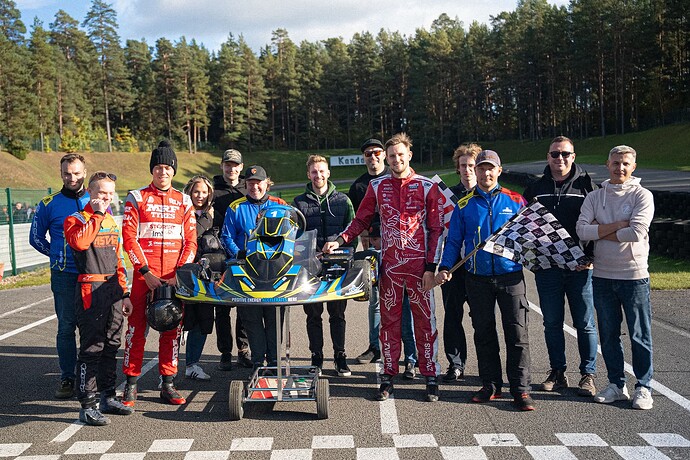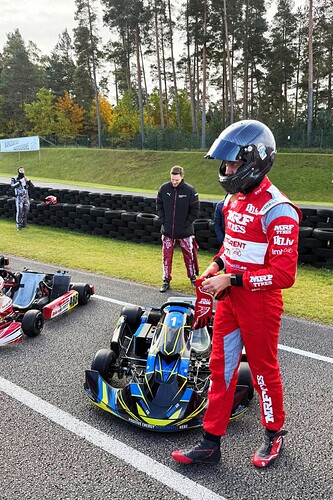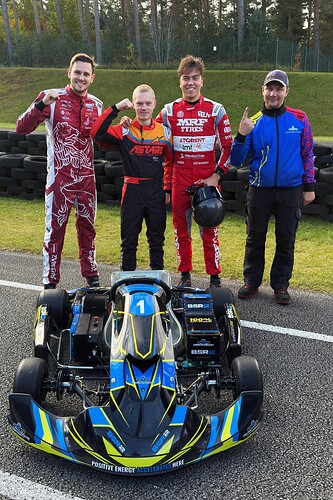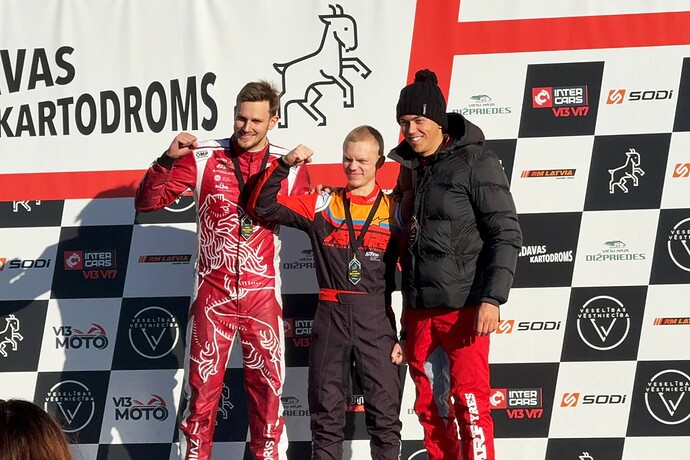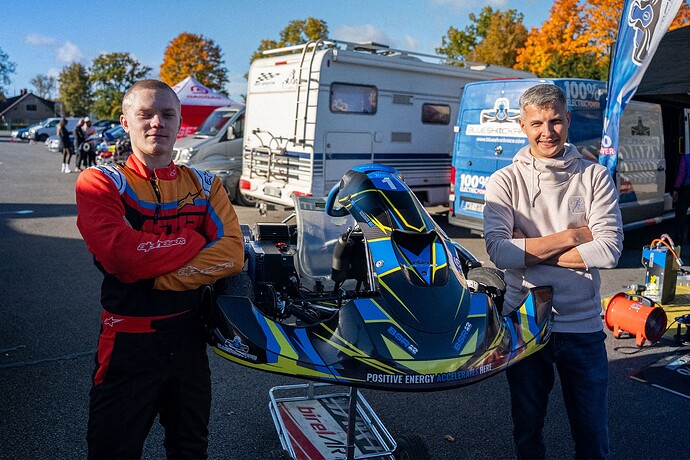By BSR Team – October 11, 2025
Karting is a sport built on limits. How far can you push the engine? How much can the driver endure? How long can a machine run at the edge before it gives out?
This autumn, at the Kandava track, we decided to put our own limits to the test. Not in theory. Not on paper. But against the toughest competition possible — the 125cc 2-stroke, 34hp shifter karts, a class legendary for its speed, brutality, and mechanical demands.
And we weren’t coming with a combustion engine.
We brought an electric kart.
Our goal was simple: Make in 4 hours as much as possible, on equal terms with some of the fastest combustion karts in Europe. No one had ever done it before, not with an electric platform.
From an Idea to the Grid
One week before the race, we ran a 2-hour test at Jelgava. The target was clear: learn the rhythm, test our pit strategy, and see if our quick-swap battery system could hold the pace for 16–18 minute stints with 30-40% left energy in the battery.
It worked. And so we came to Kandava confident — not overconfident — but ready to show that electric could go the distance.
Only, as racing tends to do, things didn’t go according to plan.
The Wrong Software, The Wrong Start
We planned to run with the X5 setup — a more aggressive map that pushes the limits of the power unit. Alongside, we had prepared an experimental X6 build for diagnostics only.
On race morning, we realized something was off: the X5 wasn’t there. The files loaded were for X4 and X6 only. Believing we were on X5, we tried to tweak gear ratios to make up the missing seconds — not knowing the kart was running X4 all along.
Once we discovered the mistake, we made a tough call: switch software mid-race. The fallback version went in, but it wasn’t properly calibrated. Worse — it wasn’t compatible with our telemetry system.
Suddenly, we were blind. No real-time data. No battery readings.
Three Drivers, One Mission
We couldn’t have asked for a better team behind the wheel:
-
Martins Sesks – WRC Rally Driver
-
Valters Zviedris – Porsche GT Driver
-
Richards Vecvagars – Professional Karting Driver
These three didn’t just “drive.” They listened to the kart, saved energy where needed, and fought hard without the crutch of telemetry. Lap after lap, they kept us in the race.
After 246 laps — roughly 250 km — we finished only 6% off the pace of the top combustion entries.
When Old Hardware Fights Back
In the final laps, Martins noticed the kart beginning to restart itself under safety protocols. Considering that this power unit is already seven years old — one that has survived nearly every BSR record attempt and the harshest test scenarios — the fact that it still carried us through the full distance with strong performance is remarkable.
The culprit turned out to be a small but critical component: the safety relay, which finally began to give out under the stress of 4 hours at race pace. It caused the late-race restarts, but it didn’t stop us from finishing — and from reaching the 250 km milestone.
Across the race, we used six new batteries plus two older backup packs — more for safety than necessity. In total, we made 13 pit stops, while most combustion teams stopped around 9–10 times. Some of our extra stops were a direct result of the relay issue, so the difference was logical and expected.
A Nod to AiM & MyChron 6: Data is the Next Weapon
This race also gave us a chance to finally push AiM’s MyChron 6 system with our electric platform. For years, telemetry for e-karts was limited. Now, with BSR’s integration, drivers and teams can see everything: battery state, RPM, temperatures, energy cycles, and more.
For anyone running BSR-X2, X3, X4, or X5 power units, the MyChron 6 can now be ordered with BSR firmware, ready to plug in and give you full data. (X1 is excluded — it’s designed as a kids’ entry product and doesn’t need advanced telemetry.)
For existing users, hardware upgrades can make the system compatible. It’s not just a gadget — it’s the next step in turning electric karting into a precision sport where data guides performance and driver growth.
Why Endurance Matters
Sprint racing is fun. But endurance? That’s where machines reveal their true soul. Can they last? Can they handle the heat, the stress, the mistakes?
For us, this 4H race was never about climbing the podium. It was about proving that electric karts can live, breathe, and fight on the same track as combustion machines — not just for minutes, but for hours.
Our long-term vision is clear:
-
Unlimited endurance through smart battery swaps. With an efficient pit strategy, 4-battery rotations could already cover virtually endless distances.
-
Next-gen power units that need only two batteries per whole race. With swap capability between sessions, this will change the game entirely.
-
Weight parity — or even lighter. Today, our top-class karts are only 8–12% heavier than combustion, and in some classes the gap is down to just 3%. But we’re not stopping until we reach full equality — or beyond.
Because endurance isn’t just about lasting longer, it’s about showing that electric racing is not an alternative anymore. It’s the future.
And let’s not forget who we were up against. On that grid were some of the toughest names in karting today — including World Champion Tomass Stolcermanis, FIA Academy drivers, and multiple Baltic champions.
*This wasn’t a casual race. It was a super pro-level endurance battle, showcasing the absolute highest performance possible in this class on a world stage. And that’s exactly why this milestone matters: because electric didn’t just survive it — electric belonged there.
*
What do you think about it?
